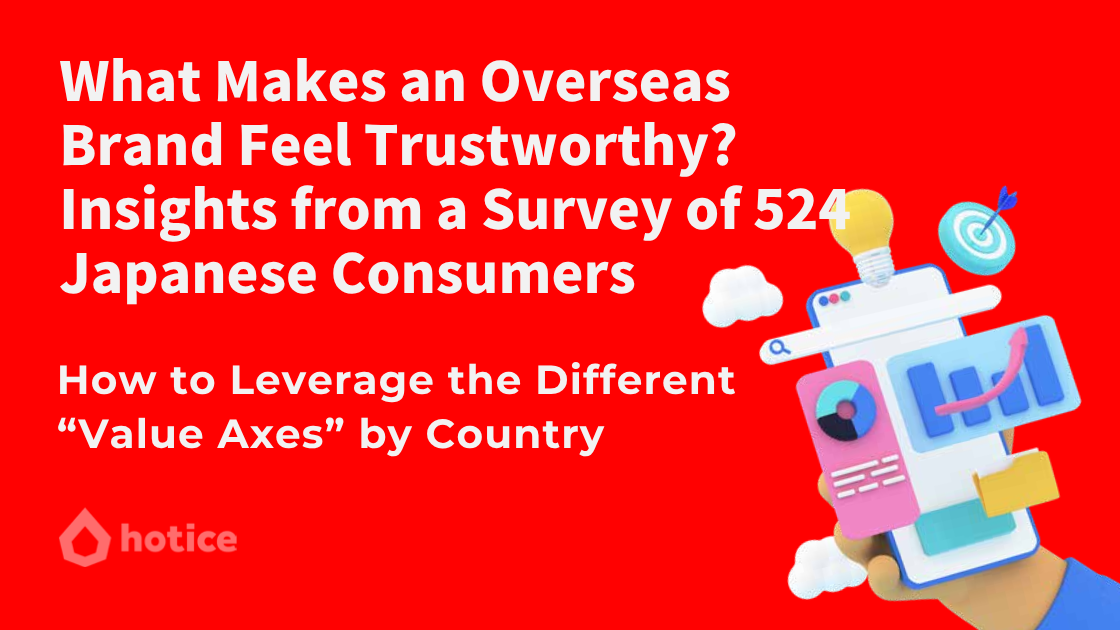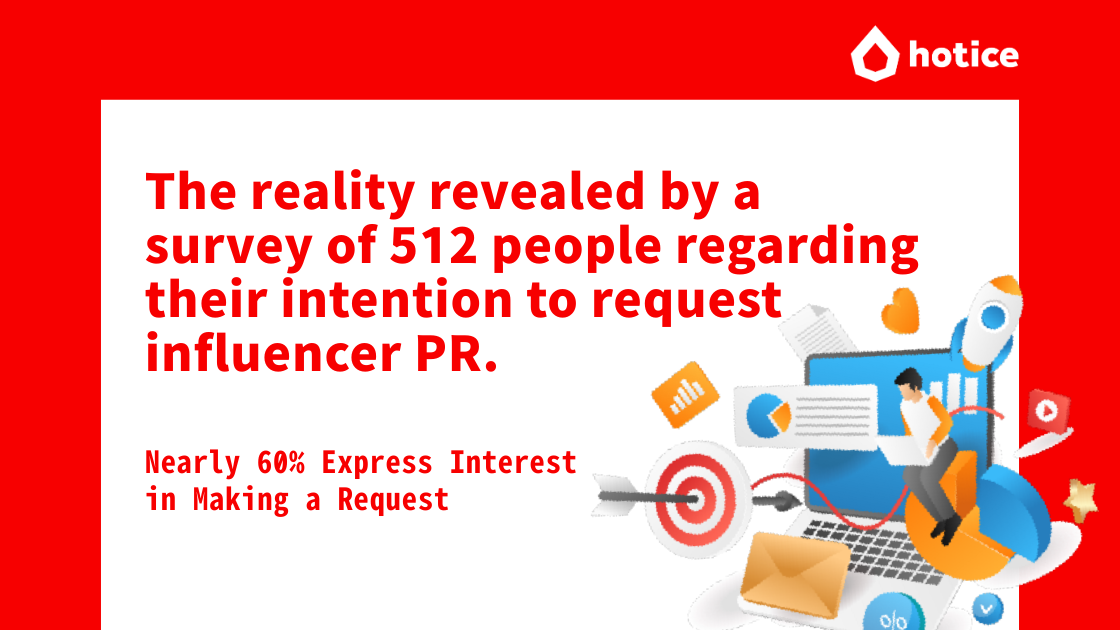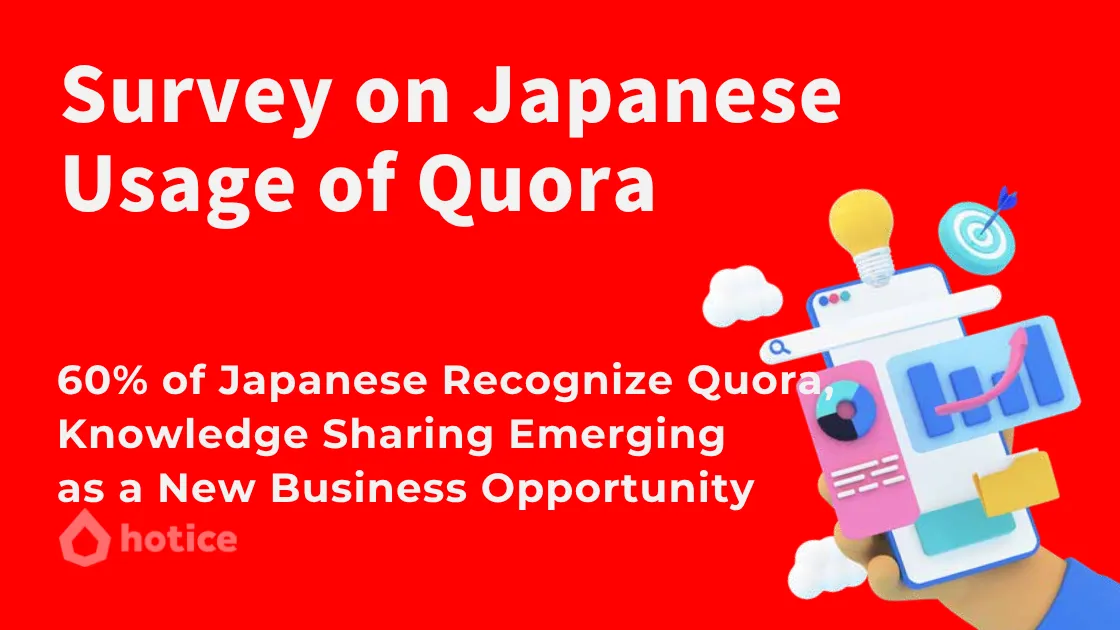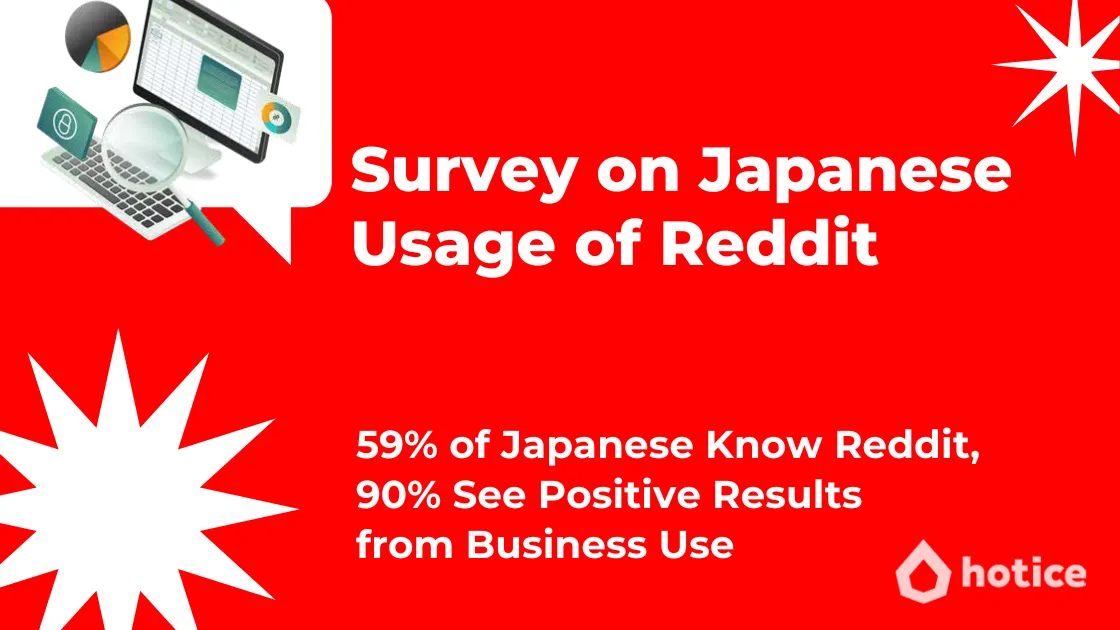We Asked 192 Japanese Consumers: What’s Your Impression of Influencers?
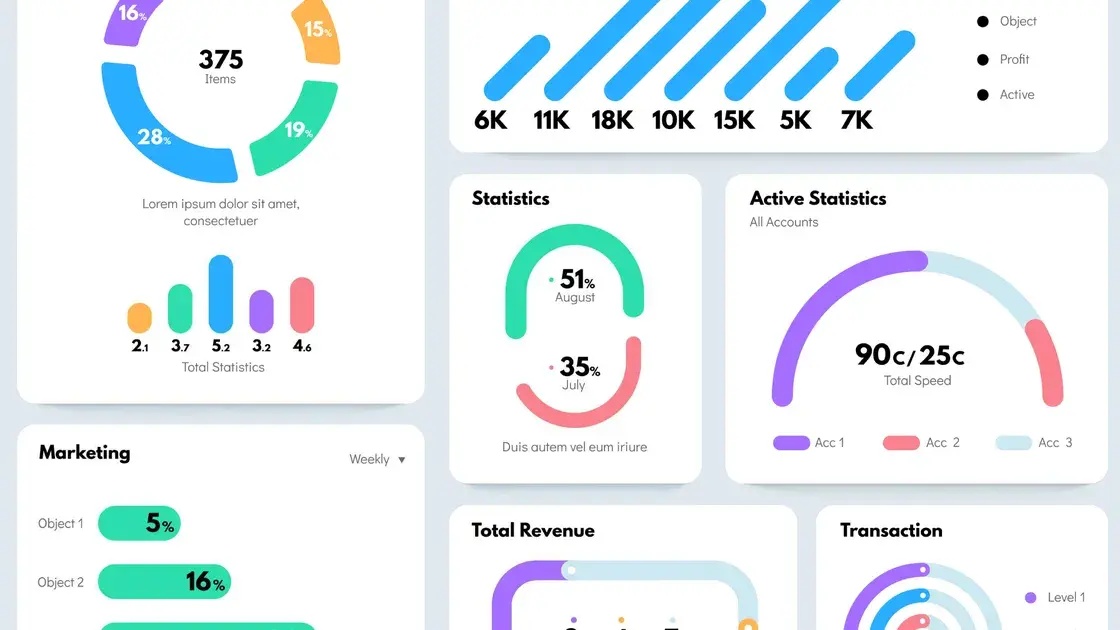
Today, influencer posts aren’t just conversation starters—they’re integral to driving real conversions.
But what exactly do Japanese users expect from influencers? What kinds of posts do they trust, and why?
At hotice, we conducted a proprietary survey targeting Japanese consumers to uncover authentic trends that go beyond guesswork. We asked:
- Which types of influencers are most popular?
- How do influencer posts influence purchasing decisions?
- How do people perceive sponsored content or stealth marketing?
Our findings reveal that influencer impact in Japan is deeply rooted in emotional connections—particularly empathy and trust. For brands, success in influencer marketing hinges on how effectively these emotional touchpoints are crafted.
When it comes to winning strategies in Japan, relying on numbers and lived reality—not assumptions—is what makes or breaks a campaign. This article offers actionable insights and data-driven analysis to help you build influencer marketing strategies that truly resonate with Japanese audiences.
Where Is Japanese Marketing Headed? The Rise of Influencer-Driven Strategies
In Japan, influencer marketing has evolved from a trend to a standard business practice.
As social media platforms become increasingly embedded in daily life, they’ve opened up new points of connection between brands and consumers.
Why Influencer Marketing Is Thriving in Japan
In recent years, the presence of influencer marketing in Japan has grown significantly. This growth is fueled by rising social media usage—particularly platforms like Instagram, TikTok, and YouTube, which offer highly visual and emotionally engaging content.
Unlike traditional mass media, these platforms enable brands to connect directly and organically with audiences who are often out of reach via conventional advertising.
Among younger generations like Gen Z and Millennials, there is a growing preference for emotional connections with “trusted individuals” rather than faceless brands. Influencers, with their relatability and human touch, are increasingly seen as essential partners for driving product awareness and brand understanding.
Why Brands Are Turning to Influencers—and What They Expect
Companies don’t just work with influencers to promote a product—they do so to build brand identity, foster relationships with untapped audiences, and cultivate loyal communities over time.
Our survey found that many consumers had made purchases based on influencer content, validating the direct impact influencers can have on buying behavior. Their ability to spark conversations and generate engagement outperforms traditional, one-way advertising formats.
Today, leveraging influencers is not just a “nice to have” in Japan—it’s a strategic imperative for any brand aiming to stay relevant and connect with modern consumers.
What Drives Japanese Users to Follow Influencers? Emotional Triggers That Shape Marketing
Influencers in Japan are no longer just “content creators”—they play a key role in shaping consumer decisions and fostering emotional resonance.
Understanding why Japanese people follow influencers can unlock powerful cues for brands looking to deepen engagement.
Empathy and Aesthetic Vibes Over Pure Utility
According to our survey, the most common reason people follow influencers is that they provide useful information (65.1%).
However, emotional factors also ranked highly:
- “I like their overall vibe and aesthetic” (57.4%)
- “I relate to what they post” (51.5%)
- “Their personality is attractive” (48.5%)
Notably, many respondents also cited admiration and aspiration as key motivators:
- “I like their looks or style” (43.4%)
- “They inspire my fashion choices” (44.1%)
- “I want to emulate their lifestyle” (39.7%)
Clearly, following an influencer in Japan often goes beyond information gathering—it’s about emotional connection and personal aspiration.
For marketers, this means showcasing products not in isolation but as part of a relatable lifestyle. The goal isn’t just visibility—it’s to become part of a narrative users want to participate in.
What Kind of Influencers Do Japanese Users Actually Want?
The survey results reveal a unique consumer mindset: Japanese users gravitate toward influencers who are trustworthy yet approachable.
While credibility is critical—47.3% of respondents valued expertise, and 51.2% appreciated clear, informative posts—users also care about connection. Responses like “They feel close to their followers” (33.6%) and “I’ve supported them for a long time” (38.7%) highlight the importance of emotional continuity and familiarity.
This shows that in Japan, influencers aren’t just distribution channels. Their personal traits—style, tone, even warmth—play a major role in campaign effectiveness.
Collaborations that feel overly commercial or out of sync with an influencer’s usual tone can backfire. Authenticity matters.
Brands must work with the influencer’s unique persona to craft content that feels genuine. In Japan, the most effective influencer marketing campaigns strike a delicate balance between storytelling and product integration.
Which Influencers Are Popular in Japan? A Breakdown by Genre
Our survey also revealed clear preferences in terms of the types of influencers Japanese users choose to follow.
Let’s look at the top genres and the marketing takeaways behind these trends.
Top 5 Most-Followed Influencer Genres in Japan
Here are the top genres based on follower counts:
- Food & Cooking (81 responses / 42.2%)
- Fashion (68 / 35.4%)
- Beauty & Cosmetics (66 / 34.4%)
- Manga & Anime (60 / 31.3%)
- Entertainment & Celebrities (49 / 25.5%)
What these genres have in common is their high visual appeal and strong lifestyle relevance. Platforms like Instagram and TikTok—where aesthetic and video content dominate—are ideal for spreading this kind of content organically.
Genres like food, fashion, and beauty are especially powerful in Japan because they feel approachable and replicable. They invite users to try things out, creating a sense of shared experience.
Meanwhile, entertainment genres such as anime and celebrity culture foster community and shared identity—factors that can amplify content reach through fan engagement.
While genre popularity provides valuable direction, it’s not the only consideration. The real key lies in aligning influencer genre with your product’s appeal and your target audience’s context.
In the Japanese market, relevance is everything—not just who you work with, but how and why.
How Follower Trends Shift Across Age Groups
To execute influencer marketing effectively, it’s crucial to understand who your audience is—and how their preferences change with age.
Our survey broke down responses by decade, revealing distinct genre preferences by generation:
- Teens: Manga & Anime, Entertainment, Food
- 20s: Food, Fashion, Beauty
- 30s: Beauty, Fashion, Food
- 40s: Fashion, Food, Beauty
- 50s+: Food, Entertainment
Among Gen Z, influencers in expressive and entertainment-rich categories are especially popular. Social media is a space for identity, and influencers in fashion or anime offer tools for self-expression.
Older generations lean toward practicality and lifestyle relevance, preferring influencers who offer ideas they can apply in daily life.
Food influencers, in particular, perform well across all age groups due to the universal nature of their content and its practical utility.
In Japan, influencer marketing isn’t one-size-fits-all. Success depends on how precisely you target age-specific needs with the right genre and narrative. Different generations respond to different value propositions—understanding these nuances is vital for ROI.
Do Influencer Posts Actually Drive Purchases? The Real Impact on Japanese Consumer Behavior
Influencer content in Japan goes far beyond boosting awareness—it can directly trigger purchases.
So, how much do Japanese consumers actually act on influencer recommendations? Let’s take a data-driven look at how influencers shape buying behavior.
70% Have Bought a Product After Seeing an Influencer Post
In our survey, 136 out of 192 respondents (70.8%) said they had purchased a product or service after seeing it featured in an influencer’s post.
This striking figure confirms that influencer marketing in Japan is no longer about indirect influence—it’s a proven catalyst for action.
Consumers in Japan aren’t just liking or following—they’re investing. This depth of trust and engagement is particularly strong among Gen Z and Millennials, for whom social media often serves as the first point of contact with new products.
Even higher-priced items such as gadgets or home appliances have seen traction via influencer content. Categories like fashion and beauty—where real-life use can be visually showcased—tend to see the highest conversion rates.
For marketers, this signals a clear truth: in Japan, influencer campaigns aren’t just about brand image—they’re performance channels that drive measurable results. As such, choosing influencers who can deliver quantifiable impact will only become more crucial going forward.
What Inspires Japanese Consumers to Buy? The Power of Visuals, Realism, and Trust
What exactly prompts Japanese users to make a purchase after seeing influencer content?
Our survey pinpointed three key factors that consistently drive conversions.
The most cited reason was “the image or video was visually appealing” (78 responses). Visual first impressions matter deeply—especially on platforms like Instagram and TikTok, where high-quality visuals directly affect buying interest.
Next came “the post had detailed information” (70) and “the product seemed genuinely used” (66), highlighting the growing demand for real-life, experience-based content.
When influencers share honest, personal impressions—rather than generic endorsements—it fosters a sense of empathy and lowers barriers to purchase.
The third major driver? “It was recommended by someone I trust” (59). In Japan, who delivers the message can be just as important as what the message is.
By contrast, sales promotions like “limited-time campaigns” (25) played a much smaller role, suggesting that emotional and informational value far outweigh simple incentives.
Ultimately, three elements emerge as critical in driving purchase intent through influencer content in Japan:
visual appeal, depth of information, and personal trustworthiness.
Brands must now focus not only on what is shared, but how it is communicated—with attention to detail, transparency, and tone.
Trust and Skepticism: How Japanese Users View Influencer Ads
Influencer marketing is a powerful tool in Japan, but it comes with a delicate balancing act: earning trust without triggering skepticism.
How do Japanese consumers actually feel about influencer promotions, especially when they’re clearly labeled as ads?
Is the #PR Label a Sign of Honesty—or a Red Flag?
When asked how they feel about posts labeled with “#PR” or “#sponsored,” most respondents (80) answered “it depends on the content.” This indicates that the quality of the message and the credibility of the influencer matter more than the label itself.
Other responses were split between caution and reassurance:
- “I feel a bit wary” (61)
- “It makes me trust the post more because it’s transparent” (40)
This suggests that transparency in influencer marketing isn’t inherently harmful. In fact, being upfront about paid partnerships can actually enhance credibility—if the content feels authentic.
That said, 17 people said they “tend to avoid” such posts, revealing a lingering discomfort with overt advertising.
In Japan, where consumers are particularly sensitive to commercial tone, even clearly disclosed ads must be thoughtfully crafted.
The content should feel worth reading, even when the viewer knows it’s promotional.
To succeed with influencer marketing in Japan, it’s not just about whether #PR is disclosed—but how the story is told, and whether it retains a sense of personal truth.
What Japanese Users Really Think About Stealth Marketing and Exaggerated Claims
One of the biggest risks in influencer marketing is crossing the line into stealth marketing—where promotional content is disguised as neutral opinion. So, how do Japanese consumers feel about this?
When asked, “How do you feel about hidden promotions or exaggerated claims?”, the top answer was “I feel somewhat uneasy” (93), followed by “I feel very uneasy” (51).
In total, about 75% of respondents expressed discomfort with deceptive or overhyped content.
While some users were more tolerant—54 said “it doesn’t bother me” and 36 said “I don’t care”—these were in the minority.
This sends a strong message: Japanese users may trust influencers more than brands, but only if that trust is not violated.
Notably, Japanese consumers don’t reject advertising outright. As shown earlier, many said they’re fine with sponsored posts as long as the content is honest and valuable.
It’s not the existence of marketing that causes friction—it’s the lack of transparency. People expect brands and influencers to be upfront.
For companies operating in Japan, the takeaway is clear: transparency and sincerity must come first.
Disclosing sponsorships, explaining the context, and allowing influencers to speak in their own voice are essential steps toward building long-term trust.
Influencer marketing in Japan isn’t just about reach—it’s about becoming a bridge of trust between brands and everyday people.
Understanding what triggers discomfort, and steering clear of it, is not just smart—it’s non-negotiable.
What Do Japanese Users Do After Seeing an Influencer Post?
Influencer posts aren’t the end of the journey—they’re just the beginning. Japanese consumers often take further action after seeing content from an influencer.
Let’s explore the top behaviors users engage in after viewing an influencer’s post.
Top 5 Consumer Actions After Viewing Influencer Content in Japan
When asked what actions they took after seeing an influencer’s post (multiple responses allowed), here’s what users said:
- Searched on Google (114 responses)
- Looked it up on e-commerce sites like Amazon or Rakuten (105)
- Watched review videos on YouTube (88)
- Searched on social media platforms like Instagram or X (80)
- Checked the product in-store (58)
This shows that influencer marketing in Japan clearly functions as a starting point for purchase decisions.
Some users buy immediately after seeing a post—but many conduct follow-up research, compare options, and then decide.
The high frequency of Google and e-commerce searches underscores the importance of having strong follow-through in your online presence.
Japanese consumers prioritize trust and tangible proof. Review videos and real-world product checks are all part of their decision-making process.
Brands that rely solely on influencer posts without considering the full journey risk leaving conversions on the table.
From product pages to third-party reviews, the entire content ecosystem must be optimized to support the actions triggered by influencer engagement.
Immediate Buyers vs. Cautious Researchers—Where’s the Line?
In our survey, 15 out of 192 respondents (7.8%) said they bought a product immediately after seeing an influencer’s post.
However, the majority indicated that they take additional steps—like searching, comparing, and verifying—before making a purchase.
This tells us that most Japanese consumers are cautious decision-makers. Influencer posts spark interest, but rarely seal the deal on their own.
So what tips a user into becoming an immediate buyer?
- The post feels authentic and relatable
- The influencer’s voice is convincing and consistent
- The product is already on the user’s radar
When these conditions align, influencer marketing in Japan can lead to direct conversions.
For those who prefer a thorough approach, your strategy should extend beyond the post itself.
Providing review links, social proof, and accessible product information can help overcome hesitation and move the user closer to a decision.
In short, Japanese influencer marketing must address both audience types:
- For fast decision-makers: offer strong, emotionally resonant content.
- For careful researchers: provide clarity, credibility, and resources to explore.
Only by designing for both can you unlock the full value of influencer-driven campaigns in Japan.
Final Takeaways—Influencers Drive Empathy, Trust, and Sales in Japan
Our survey reveals a powerful truth: in Japan, trust in influencers is emotional, not transactional—and it has real impact on behavior.
So what does that mean for future social media strategies in this market?
The New Formula—Empathy, Credibility, and Aesthetic Alignment
Japanese consumers don’t just want accurate information. They want it from someone they trust, admire, and relate to.
They follow influencers not just because of what they say, but how they say it—and who they are.
Terms like “relatable personality,” “consistent vibe,” and “aspirational lifestyle” ranked almost as high as “useful information” in our survey.
In Japan, influencers are not just messengers—they are emotion carriers.
This emotional resonance also explains why PR tags aren’t always a deal-breaker, and why stealth marketing backfires so often.
The takeaway?
- Transparency matters
- Tone matters
- Authenticity matters most
When brands allow influencers to communicate sincerely, even sponsored content can feel trustworthy and welcome.
Where Should Brands Go from Here? Actionable Steps for the Japanese Market
Influencer marketing in Japan isn’t just a trend—it’s a strategic core. But that doesn’t mean “more followers = better results.”
Based on our findings, here’s what brands must prioritize moving forward:
- Values-first alignment: Work with influencers whose lifestyle and worldview naturally align with your brand. That’s what creates believable, engaging content.
- Long-term relationships: Don’t just hire influencers for a one-off campaign. Recurring collaborations build deeper audience trust and establish the influencer as a true advocate.
- Cross-platform strategy: Don’t stop at the post. Optimize every step—landing pages, product reviews, purchase flow—so users have the resources to act.
- Built-in transparency: Own your sponsored content. Let influencers speak in their voice. In Japan, sincerity earns more than spin.
The era of “just getting the word out” is over. Japanese consumers now demand emotional relevance, informational depth, and narrative trust.
hotice is here to help you meet those expectations—and build influencer campaigns that don’t just reach people, but move them.
Partner with hotice to Unlock the Power of Influencer Marketing in Japan
This survey confirmed what we’ve long seen on the ground: influencers in Japan are more than amplifiers—they’re decision shapers.
Emotional alignment, cultural fluency, and platform expertise are essential for making an impact.
At hotice, we specialize in influencer marketing tailored to the Japanese market. From influencer selection to campaign execution and analytics, we help brands:
- Connect with trusted voices
- Design emotionally resonant campaigns
- Translate social engagement into real business outcomes
Whether you’re a global brand or new to the Japanese market, we’re here to help you turn empathy into action.
Let’s build a strategy that doesn’t just perform—let’s make it relatable, repeatable, and real.
Talk to us today and start creating trust-driven marketing that moves Japan.


